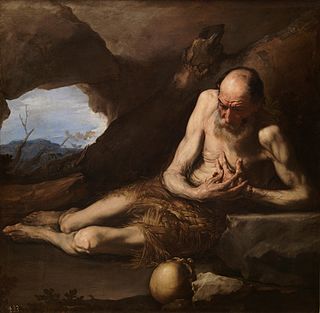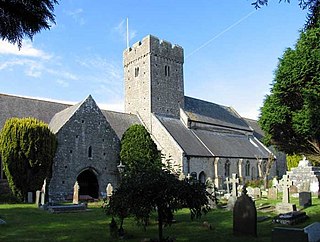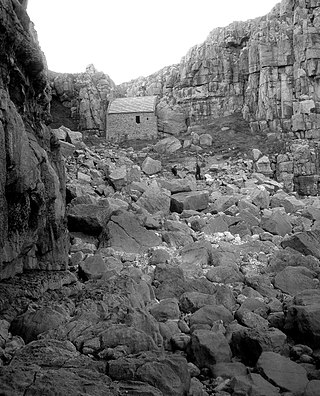
Port Talbot is a town and community in the county borough of Neath Port Talbot, Wales, situated on the east side of Swansea Bay, approximately eight miles from Swansea. The Port Talbot Steelworks covers a large area of land which dominates the south east of the town. It is one of the biggest steelworks in the world, but has been under threat of closure since the 1980s. The population was 31,550 in 2021, comprising about a fifth of the 141,931 population of Neath Port Talbot.

Gildas — also known as Gildas Badonicus, Gildas fab Caw and Gildas Sapiens — was a 6th-century British monk best known for his scathing religious polemic De Excidio et Conquestu Britanniae, which recounts the history of the Britons before and during the coming of the Saxons. He is one of the best-documented figures of the Christian church in the British Isles during the sub-Roman period, and was renowned for his Biblical knowledge and literary style. In his later life, he emigrated to Brittany where he founded a monastery known as Saint-Gildas-de-Rhuys.

Samson of Dol was a Welsh saint, who is also counted among the seven founder saints of Brittany with Pol Aurelian, Tugdual or Tudwal, Brieuc, Malo, Patern (Paternus) and Corentin. Born in southern Wales, he died in Dol-de-Bretagne, a small town in north Brittany.
The Culdees were members of ascetic Christian monastic and eremitical communities of Ireland, Scotland, Wales and England in the Middle Ages. Appearing first in Ireland and then in Scotland, subsequently attached to cathedral or collegiate churches; they lived in monastic fashion though not taking monastic vows.

Neath is a market town and community situated in the Neath Port Talbot County Borough, Wales. The town had a population of 50,658 in 2011. The community of the parish of Neath had a population of 19,258 in 2011. Historically in Glamorgan, the town is located on the River Neath, seven miles east-northeast of Swansea.

Llantwit Major is a town and community in Wales on the Bristol Channel coast. It is one of four towns in the Vale of Glamorgan, with the third largest population after Barry and Penarth, and ahead of Cowbridge. It is 4+1⁄2 miles (7.2 km) from Cowbridge, 9 miles (14 km) from Bridgend, 10 miles (16 km) from Barry, and 15 miles (24 km) from Cardiff. It had a population of 9,530 in 2021.

Briton Ferry is a town and community in the county borough of Neath Port Talbot, Wales. The Welsh name may indicate that the church, llan, is protected from the wind, awel. Alternatively, Sawel may be a derivative of Saul, St Paul's earlier name. He once landed at Briton Ferry. An alternative Welsh name unused today is Rhyd y Brython, a direct translation of Briton Ferry. The Normans referred to the River crossing as La Brittonne and Leland in 1540 as Britanne Fery.

Aberavon is a town and community in Neath Port Talbot county borough, Wales. The town derived its name from being near the mouth of the river Afan, which also gave its name to a medieval lordship. Today it is essentially a district of Port Talbot, covering the central and south western part of the town. Aberavon is also the name of the nearby Blue Flag beach and the parish covering the same area.

Paul Aurelian was a 6th-century Welshman who became first bishop of the See of Léon and one of the seven founder saints of Brittany. He allegedly died in 575, rumoured to have lived to the age of 140, after having been assisted in his labors by three successive coadjutors. This suggests that several Pauls have been conflated. Gilbert Hunter Doble thought that he might have been Saint Paulinus of Wales.

River Neath is a river in south Wales running south west from the point at which its headwaters arising in the Brecon Beacons National Park converge to its mouth at Baglan Bay below Briton Ferry on the east side of Swansea Bay.

Illtud, also known as Illtud Farchog or Illtud the Knight, is venerated as the abbot teacher of the divinity school, Bangor Illtyd, located in Llanilltud Fawr in Glamorgan, Wales. He founded the monastery and college in the 6th century, and the school is believed to be Britain's earliest centre of learning. At its height, it had over a thousand pupils and schooled many of the great saints of the age, such as David, Samson of Dol, and the historian Gildas.

Paul of Thebes, commonly known as Paul the First Hermit or Paul the Anchorite, was an Egyptian saint regarded as the first Christian hermit and grazer, who was claimed to have lived alone in the desert of Thebes, Roman Egypt from the age of sixteen to the age of one hundred and thirteen years old. He was canonized in 491 by Pope Gelasius I, and is venerated as a saint by the Catholic Church, Eastern Orthodox Church, and Oriental Orthodox Churches.

Saint Cadoc or Cadog was a 5th–6th-century Abbot of Llancarfan, near Cowbridge in Glamorgan, Wales, a monastery famous from the era of the British church as a centre of learning, where Illtud spent the first period of his religious life under Cadoc's tutelage. Cadoc is credited with the establishment of many churches in Cornwall, Brittany, Dyfed and Scotland. He is known as Cattwg Ddoeth, "the Wise", and a large collection of his maxims and moral sayings were included in Volume III of the Myvyrian Archaiology. He is listed in the 2004 edition of the Roman Martyrology under 21 September. His Norman-era "Life" is a hagiography of importance to the case for the historicity of Arthur as one of seven saints' lives that mention Arthur independently of Geoffrey of Monmouth's Historia Regum Britanniae.

St Illtyd's Church is a church complex in Llantwit Major, Vale of Glamorgan, southeast Wales. It is located at the site of the oldest college in the United Kingdom, once believed to have been founded as Côr Tewdws c. AD 395 by the Roman Emperor Theodosius II. It is now generally accepted as having been founded by St. Illtud c. AD 508, from whom it derives its name. The current church building was built in the 11th century by the Normans, with portions being rebuilt in the 13th and 15th centuries. The church building is one of the oldest and best-known parish churches in Wales. It is a grade I listed building, or building of exceptional interest, and has been called both the "Westminster Abbey of Wales" for its unique collection of carved stones and effigies, and "the most beautiful church in Wales."

Baglan is a village in Wales, adjoining Port Talbot, named after Saint Baglan. It is also a community and ward in the Neath Port Talbot county borough. In 2001, the population was 6,654. rising to 6,819 in 2011.

Saint Colman mac Duagh was born at Corker, Kiltartan, County Galway, Ireland, the son of the Irish chieftain Duac. He initially lived as a recluse, living in prayer and prolonged fastings, first on Inismore, then in a cave at the Burren in County Clare. With his relative, King Guaire Aidne mac Colmáin of Connacht he founded the monastery of Kilmacduagh,, and governed it as abbot-bishop.
There is archaeological evidence of insular monasticism as early as the mid 5th century, influenced by establishments in Gaul such as the monastery of Martin of Tours at Marmoutier, the abbey established by Honoratus at Lérins; the abbey of Mont-Saint-Michel; and that of Germanus at Auxerre. Many Irish monks studied at Candida Casa near Whithorn in what is now Galloway in Scotland.

Padarn was an early 6th century British Christian abbot-bishop who founded St Padarn's Church in Ceredigion, Wales. He appears to be one and the same with the first bishop of Braga and Saint Paternus of Avranches in Normandy. Padarn built a monastery in Vannes and is considered one of the seven founding saints of Brittany. Padarn's early vita is one of five insular and two Breton saints' lives that mention King Arthur independently of Geoffrey of Monmouth's Historia Regum Britanniae.

Saint Govan was a hermit who lived in a fissure on the side of coastal cliff near Bosherston, in the Pembrokeshire Coast National Park, Wales. St. Govan's Chapel was built in the fissure in the 13th century on what is now known as St. Govan's Head.

St Catharine's Church is the mother church of the parish of Baglan in Port Talbot, South Wales.

















